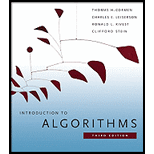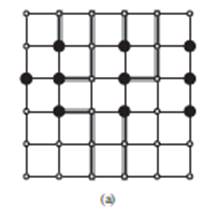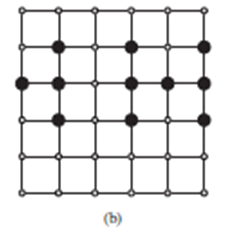
(a)
To explain the determining of the maximum flow in a network with edge and vertex capacities can be reduced to an ordinary maximum-flow problem on a flow network of comparable size.
(a)
Explanation of Solution
Given Information:The network is given below:

Explanation:
The constraints can be covered by splitting the vertex into two then the edge in between two vertices of the network will be the vertex capacity for the graph.
The maximum flow of the network is determined by consider the path so that the graph has maximum capacity.
The steps to determine the maximum-flow is given below:
Step 1: Split the vertex into 2 and formed new network of vertices u and v.
Step 2: The splitting results the new vertices of new network is
Step 3: Check the graph for edge
Step 4: The new network consists of edge as
Step 5: To obtain the maximum flow consider the v as it goes from
Thus, in this way the new flow network is formed having maximum flow.
(b)
To describes an efficient
(b)
Explanation of Solution
Given Information:The figure with no escape grid is given below:

Explanation:
The escape problem can be solved as follows:
Step 1: Built a flow network with unit capacity by considering vertex constraints.
Step 2: Consider the above figure select the unit edge that intersecting the grid lines of adjacent grid.
Step 3: The available network has bidirectional edges with unit capacity so put a unit capacity corresponding to edges going to source s to other vertices.
Step 4: The capacity of the edges is unity so all the augmented paths will be unity.
Step 5: The augmented path defines the path to escape that is escape path is equal to m , where m is vertex disjoint path.
Step 6: Checks the value of maximum flow if it is less than the m then it is not the required escape path.
The path obtained from the above algorithm can be crossed verified by the vertex disjoint path it satisfy the equality then it is required escape path otherwise the flow network cannot have any escape path.
Want to see more full solutions like this?
Chapter 26 Solutions
Introduction to Algorithms
- Please solve and answer the questions correctly please. Thank you!!arrow_forwardConsidering the TM example of binary sum ( see attached)do the step-by-step of execution for the binary numbers 1101 and 11. Feel free to use the Formal Language Editor Tool to execute it; Write it down the current state of the tape (including the head position) and indicate the current state of the TM at each step.arrow_forwardI need help on inculding additonal code where I can can do the opposite code of MatLab, where the function of t that I enter becomes the result of F(t), in other words, turning the time-domain f(t) into the frequency-domain function F(s):arrow_forward
 C++ for Engineers and ScientistsComputer ScienceISBN:9781133187844Author:Bronson, Gary J.Publisher:Course Technology Ptr
C++ for Engineers and ScientistsComputer ScienceISBN:9781133187844Author:Bronson, Gary J.Publisher:Course Technology Ptr C++ Programming: From Problem Analysis to Program...Computer ScienceISBN:9781337102087Author:D. S. MalikPublisher:Cengage Learning
C++ Programming: From Problem Analysis to Program...Computer ScienceISBN:9781337102087Author:D. S. MalikPublisher:Cengage Learning Operations Research : Applications and AlgorithmsComputer ScienceISBN:9780534380588Author:Wayne L. WinstonPublisher:Brooks Cole
Operations Research : Applications and AlgorithmsComputer ScienceISBN:9780534380588Author:Wayne L. WinstonPublisher:Brooks Cole EBK JAVA PROGRAMMINGComputer ScienceISBN:9781337671385Author:FARRELLPublisher:CENGAGE LEARNING - CONSIGNMENTProgramming Logic & Design ComprehensiveComputer ScienceISBN:9781337669405Author:FARRELLPublisher:Cengage
EBK JAVA PROGRAMMINGComputer ScienceISBN:9781337671385Author:FARRELLPublisher:CENGAGE LEARNING - CONSIGNMENTProgramming Logic & Design ComprehensiveComputer ScienceISBN:9781337669405Author:FARRELLPublisher:Cengage Fundamentals of Information SystemsComputer ScienceISBN:9781305082168Author:Ralph Stair, George ReynoldsPublisher:Cengage Learning
Fundamentals of Information SystemsComputer ScienceISBN:9781305082168Author:Ralph Stair, George ReynoldsPublisher:Cengage Learning





